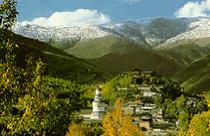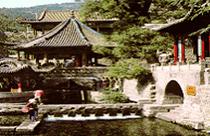CONTACT US
| +86-10-82600771 | |
| WhatsApp: +86-13911460247 | |
| Messenger: chinatournet | |
WeChat ID: callchinatour | |
Jinci Temple is located at the source of the Jin River by Xuanwang Hill, 25km southwest of Taiyuan. It was estimated that the temple was originally built between 1023 and 1032, but in the later years, the temple was repaired and restored repeatedly till Qing dynasty.


When you enter the temple, the first major structure come to you is
the Mirror Terrace, a Ming building which served as an open-air theatre. To the
west of the Mirror Terrace is the Zhibo's Canal, which cuts through the temple
complex with a bridge named Huixian (Meet the Immortals) Bridge above it. The
bridge provides an access to the Terrace for Iron Statues, which displays
figures cast in 1097.
The Goddess Mother Hall is the oldest wooden building
in the city as well as one of the most interesting spot in the temple complex.
Inside are 42 Song dynasty clay figures of maidservants standing around a large
seated statue of the sacred lady, said to be the mother of Prince Shuyu of the
ancient Zhou dynasty.
Next to the Goddess Mother Hall is the Zhou Cypress, an
unusual tree which has supposedly been growing at an angle of about 30 for the
last 900 years.
The famous Zhenguan Baohan Pavilion lies in the north of the
temple grounds, in which four stone steles inscribed with the handwriting of the
Tang Emperor Tai Zong are contained. In the south of the temple grounds is the
Sacred Relics Pagoda, a seven storey octagonal building constructed at the end
of the 7th century.